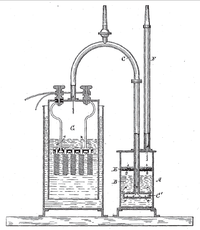
Photo from wikipedia
Abstract In this study, a solar and wind energy-based system integrated with H2 O2 combustor is developed to produce fresh water from sea-water desalination, electricity, cooling, hydrogen, and oxygen as… Click to show full abstract
Abstract In this study, a solar and wind energy-based system integrated with H2 O2 combustor is developed to produce fresh water from sea-water desalination, electricity, cooling, hydrogen, and oxygen as well as to provide food drying and domestic water heating. The main components of the proposed system contains concentrated solar power (CSP), wind turbine, Rankine cycle, multi stage flash (MSF) desalination unit, water electrolyzer, a refrigeration unit, a food drying system, oxy-hydrogen combustor, domestic water heater, as well as hydrogen and oxygen storage units. Furthermore, for continuous operation of the system during night time and in cloudy weather conditions, a thermal energy storage (TES) unit and oxy-hydrogen combustion unit are integrated to the system. Based on energy and exergy balances, performance assessment of the proposed system is conducted. Moreover, effects of various parameters such as solar irradiation, wind speed and ambient temperature on some of the outputs of the system are investigated. The results illustrate that the proposed system fulfills most of the remote community requirements in an efficient, environmentally benign and uninterrupted way. The obtained results for the reference case show that with installation of parabolic trough concentrators (PTCs) on an area of 111,728 m2, the plant produces net electrical power of approximately 11.4 MW, approximately 828 m3/day of freshwater, about 36 kg/s of hot air for food drying, about 31 kg/s of heated domestic water, approximately 920 kg/day of H2 and about 2.26 MW of cooling. The overall energy efficiency of the system is found to be 50%, while the exergy efficiency of the system is 34%. In addition, the energy and exergy efficiencies of single generation in which there is only electrical power output are approximately 15% and 16%, respectively.
Journal Title: International Journal of Hydrogen Energy
Year Published: 2020
Link to full text (if available)
Share on Social Media: Sign Up to like & get
recommendations!